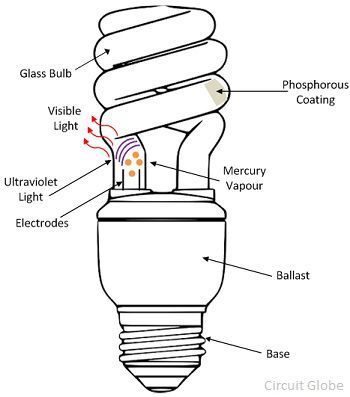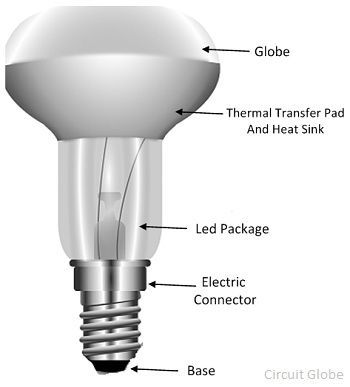The major difference between the CFL and LED is that in CFL the emission of light is because of the ionisation of mercury vapour. The mercury vapour when ionise produces ultraviolet rays. These rays when collides with phosphorous coating tube generates visible light.
Whereas in the LED it is because of the PN junction diode. When the forward current applies across the diode, the recombination of the charge carrier takes place. This charge carrier gives energy in the form of the heat and light. The other differences between CFL and LED light bulbs are represented below in the comparison chart.
The CFL and LED both are the sources of visible light. The CFL uses mercury vapour which is dangerous for the environment and living beings. Also, it requires additional components like ballast, tungsten tube coated with barium, etc., which increases their cost.
The CFL work on the principle of ionisation of vapours.The process of ionisation converts most of the visible energy in the form of heat. This heat increased the power consumption of the bulb and reduced their working duration.
The destruction of the LED is easier than the CFL because LED does not have any harmful metal which pollutes the environment. The LED uses semiconductor chip which is easily recycled by doping impurities in it.
The brightness of LED is more as compared to CFL because LED emits light only in one direction. Most of the energy generated by the diode is converted into visible light. The heat emission is very less in LED which reduces their power consumption and increases their efficiency.
Content: CFL Vs LED Bulb
Comparison Chart
| Basis For Comparison | CFL Bulb | LED Bulb |
|---|---|---|
| Definition | The CFL is defined as the lamp which uses the low pressure mercury vapour gas for producing the visible light | It is a PN junction diode which produces light when current passes through it in the forward direction. |
| Stand For | Compact Fluorescent Lamp | Light Emitting Diode |
| Working principle | The electrons of mercury when excited emits ultraviolet light. This ultraviolet light when strikes with the fluorescent coating glass converts it into the visible light. | The semiconductor material which emits light with the passage of current. |
| Power Consumption | More | Less |
| Mercury | Contain | Not contain |
| Destruction | Difficult | Easy |
| Efficient | Less | More |
| Ballast | Requires | Not requires |
| Lifespan | 10,000 hours | 50,000 hours and more. |
| Turn on Intensity | Delay | Quick |
| Expensive | Less | More |
| Emission of heat | More | Less |
| Brightness | Less | More |
| Effect of switching on/off . | Reducing lifespan | Having no effect. |
| Recyclable | No | Yes |
| Applications | For domestic purposes. | Motorcycle lights, in traffic signals, message display board etc. |
Definition of CFL
The CFL Stands for the Compact fluorescent lamp. The CFL has a fluorescent tube which is filled with the mercury vapour. The fluorescent tube is a special type of tube which is internally coated with the phosphorous. This tube absorbs the visible or invisible light of short wavelength and emits the light of longer wavelength.

When the voltage is applied to the ballast of the CFL, the vapour of mercury becomes energised and emits ultraviolet lights. This ultraviolet light generates visible light when it collides with the tube.
The CFL is mainly classified into two types, i.e. the integrated CFL lamp and the non-integrated CFL lamp. The integrated lamps have ballast and lamp which is connected to the single unit. And in the non-integrated lamp, the ballast is permanently fixed with the luminaire, and only the tube are replaced when it is damaged.
Definition of LED Bulb
The LED bulb has a PN-Junction diode which emits light when the current passes through it in the forward direction. The charge carrier emits light when they combine with each other. The led emits light only in one direction because of which the bulb has good brightness.

The LED has various advantages as compared to incandescent and fluorescent lamp. Like it consumes less power and has a long life. Also, it does not contain any harmful gases which affect the environment. The LED produces more Lumens for the same watt as that of the other lamp. The destruction of LED can easily be done because it is free from the toxic substance. The frequently switching also didn’t affect their life span.
Key Differences Between CFL and LED Bulbs
- The CFL is defined as the light bulb which uses fluorescence for producing the light whereas the LED uses the semiconductor diode for producing visible light.
- The CFL stands for compact fluorescent lamp whereas the LED stands for Light Emitting Diode.
- The CFL works on the principle of ionisation.While the LED work on the principle of the electroluminescence phenomenon. In this phenomenon, the diode emits light with the passage of the current.
- The power consumption in CFL is more as compared to LED. Because CFL uses mercury, which requires more power for ionisation.
- The CFL contains mercury vapour inside the glass tube of CFL which affect the health of living beings whereas the LED does not contain mercury.
- The destruction of CFL bulbs is difficult because it contains toxic mercury vapour. This mercury vapour has the harmful effect on the health of the human and environment whereas the destruction of LED is easy because it is free from toxins metals.
- The CFL is more efficient as compared to the LED. The efficiency of the bulb depends on the luminous flux emitted by the bulbs. The luminous flux is the rays of the visible light which are measured in Lumens. Thus, the bulb which has high Lumens for the same power is considered to be more efficient.
- The CFL requires ballast whereas the LED did not use it. The ballast is the electronic device which controls the current passes through the lamp. It also supplies the sufficient voltage requires by the lamp to start. If the ballast is not used and CFL is directly connected to the supply, then the lamp will draw the heavy current to the source. Because of which the lamp gets heated and within a second get damage.
- The turn-on intensity of the CFL is less as compared to LED because CFL contained mercury vapour which takes time for ionisation.
- The cost of the CFL is more as compared to the LED. The CFL requires additional components like gas filled tubes and the electronic component which increases their cost.
- The CFL emits most of their energy in the form of heat as compared to the LED. The CFL uses mercury as a filament which emits visible light when their ions are ionised. The ionisation occurs in high-voltage and this high voltage increases their temperature.
- The brightness of a CFL is less as compared to LED because LED emits light only in the one direction. The LED has a PN junction diode which operates only in the forward biasing. Whereas, the CFL emits light in all the direction.
- The frequent on/off of CFL reducing their capacity because CFL requires lots of energy for turning on. Thus, continuously switching reduces the ionisation property of the mercury vapour. Whereas, the LED is unaffected by constantly switching.
- The recycling of CFL is difficult as compared to LED because LED does not have any toxic substance. The LED has semiconductor which is easily recycled by adding impurities through doping.
- The CFL are used in houses or for lighting the small areas whereas LED is used for making the headlight of vehicles, traffic signals, the message displayed board, etc.
Conclusion
The LED is better than the CFL in every aspect. The LED saves up to 80 percent of the electricity bill even though their cost is very less. It is recyclable, and their brightness remains same even after using it for a long time. The frequently on/off switch also did not reduces their lifespan. Although, the CFL save energy cost up to 70 percent. And it is non-recyclable and contains mercury which has harmful effects on human. The cost of CFL is also very high and it can uses only for 6000 -10,000 hours.
